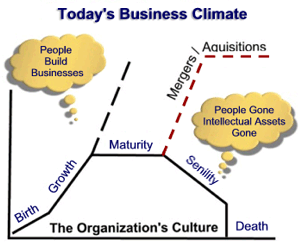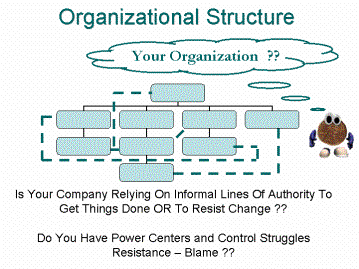|
|
|
|
|
|
|
|||||||||
|
|
|||||||||
|
|
|
Preventment In today’s competitive world, change often becomes the most important capability of any business and organization today. Without change we cannot adapt to a changing world. We will become obsolete and die. BUT you may ask…
These questions are not new. They are perhaps the most important questions that senior leadership must ask themselves today. It is not a question of what to do… But rather a question of how to do it. To answer this question we must clearly and completely define and understand the problem. Every organization begins with a new and exciting idea, a clear vision, and a handful of people dedicated to achieving it.
Every organization goes through 5 stages… Organizations start out with an idea that initially grows to a level of excellence. People are open to change and improvement. Flexibility is the common thread that runs through the organization. Then something happens called Maturity. People become territorial and resistant to change. The organization’s growth and efficiency slows and stops. Then comes Senility. The organization’s growth turns downward and finally, the organization dies. To prevent this, organizations try to develop its organizational culture through diversity. They use mergers and acquisitions to bring in new people with new ideas. However, because the organization never developed an organizational culture based on principles, the new additions only get contaminated with the old, and soon the same old problem is back. How Do You Know When This Is Happening When you look at the organization chart the structural authority is clear. It is logical and designed to provide the most effective means for communication and performance Does Your Organization Look Like This?
However, the underlying structure becomes entangled with unofficial lines of communication built by the people within the organization, resulting in getting around and bypassing the defined organizational structure. In doing so, unofficial power centers are formed. When it comes time for change, these power centers become threatened and when change is presented, the leadership of the organization is met with resistance because these unofficial power centers want to stay in control and thus intentionally or unintentionally want to keep them protected. We often hear BUT.... · We tried Leadership Training (TQM and TQL) .... all to no avail when it comes to the ability of the organization to have lasting change. We also tried to build organizations based on diversity. Yet resistance to change still happens. It is often said that when we are solving the same problem over and over and nothing changes, then perhaps we are solving the wrong problem. |
|
Contact Us About Us References
|
|
|



